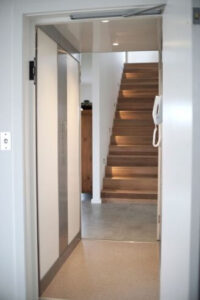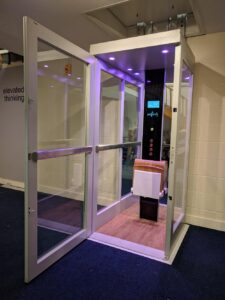Small Residential Lifts: 4 Practical Things that Really Matter
How can small residential lifts help make your life convenient?
If you’re a homeowner with limited mobility, an elderly individual interested in keeping your independence in your own house, or a homeowner who intends to add value and convenience to your property, a personal elevator or small residential lift could make your life a lot better.
 Small residential lifts let you enjoy the convenience and ease of avoiding using the stairs whenever you please! Small residential lifts come in every shape and sizes to cater to your needs and fit nicely in your home.
Small residential lifts let you enjoy the convenience and ease of avoiding using the stairs whenever you please! Small residential lifts come in every shape and sizes to cater to your needs and fit nicely in your home.
With the right small residential lift, you can keep a secure, safe, and independent lifestyle much longer, without the inconvenience or risk of having to haul heavy weights from floor to floor. Let us explore the different small residential lifts varieties and discover everything you need to know about small residential lifts before buying one for your home.
When someone in the family has mobility issues, special equipment and gear may be necessary for his or her convenience, and a small residential lift is usually the principal among these special needs. There are a variety of small residential lifts to fit any home.
Residential lift styles include glass, traditional cable, hydraulic, shaft-less, or even pneumatic models.
Imagine the convenience and ease of being able to move heavy and bulky objects such as luggage, groceries, or laundry through a dumbwaiter rather than painfully carrying them up several flights of stairs!
Types of Residential Lifts
Traditional Home lift
Hydraulic elevators or traditional cable lifts are definitely excellent options for those who need a small residential lift. These lifts provide a smooth ride and quiet operation.
Wheelchair Home Lifts
Wheelchair residential lifts are designed to help those with disabilities and mobility issues. These kinds of small residential lifts occupy less space than a traditional hydraulic elevator and could even be more cost-effective. There are various models to pick from, depending on the vertical travel distance that needs to be accommodated. A small residential lift could even help your building comply with ADA standards.
Dumbwaiters
Dumbwaiters are compact, and they save a lot of space. They are an effective solution for folks who need to haul small objects and items from floor to floor. Libraries and kitchens usually install dumbwaiters to move books and dishes.
Hydraulic Home Lifts
These piston-powered small residential lifts deliver a gentle descent and a smooth ride. They could be adapted for various designs and appropriate for different kinds of low-rise properties and establishments.
Pneumatic Residential Lift
Pneumatic residential lifts are eye-catching and sleek addition to your home. These elevators are among the safest and most dependable types of small residential lifts in the market.
Screw Drive Lift
Screw-drive residential lift systems are generally used in wheelchair residential lifts. These are slow-moving, but economical and save tons of space because they don’t need a machine room.
Glass In Home Lift
These gorgeous residential lifts are chosen for their aesthetic value. A glass elevator is unobtrusive and elegant in the home. It could likewise be used to show beautiful views in waterfront properties and high-rise buildings. A glass elevator likewise fits wonderfully into upscale homes. Occupants of glass elevators, riding in a poly carbonate-paneled cab, can enjoy a full view of the surroundings while they go up or down in their home.

MRL – Machine Room-Less Lift
A machine-room-less residential lift tends to be more affordable and save space. These versatile small residential lifts come in a variety of models and styles. The walls are usually made with recycled wood. Also, they do not use dangerous hydraulic oil, and they use half the energy than traditional residential lifts.
Shaft-less Home Lift
These small residential lifts could only travel between two floors, but they’re a great option for residential use since they don’t occupy much space. Shaft-less lifts also don’t require machine rooms or hoist ways. The price is usually low with this kind of small residential lift due to the nominal site prep involved.
Residential Lift Sizes for Your Home
 Small residential lifts could make spaces more convenient and easier to navigate, but space could be a vital consideration before pursuing this kind of installation in your home or property. Some houses lack the space required to install a large lift. With this limit in consideration, you have to look for lifts and elevators in all various configurations and sizes to fit any space.
Small residential lifts could make spaces more convenient and easier to navigate, but space could be a vital consideration before pursuing this kind of installation in your home or property. Some houses lack the space required to install a large lift. With this limit in consideration, you have to look for lifts and elevators in all various configurations and sizes to fit any space.
With conventional elevators, capacities may vary. Nevertheless, most heavy-duty models could carry up to 1,400 pounds. Standard sizes vary from as little as 48 inches by 36 inches to as huge as 54 inches by 40 inches. Bespoke sizing is likewise available for a lift as big as 18 square feet.
A shaft-less lift could be an excellent option for a house with more space limits. This lift type has an incredibly small footprint, making it convenient and easy to fit into basically any kind of home. Sizing choices are likewise available depending on the purpose of the lift, if it needs to transport a wheelchair or just people. Capacities vary from 380 to 490 pounds.
A pneumatic elevator is likewise ideal for fitting into limited spaces. The sleek cab boasts of a circular design that usually installs seamlessly and conveniently into a small space like tucked into a wrap-around stairway.
The smallest pneumatic lift has a diameter of about 30 inches with an inner diameter of approximately 20 inches. Bigger lifts have an inner diameter of 30 to 40 inches, allowing them to accommodate up to two persons or a wheelchair.
 Nevertheless, if the objective of the lift is transporting a wheelchair, you might want to choose a wheelchair lift to save more space. A vertical elevator moves along a guide rail over the staircase and uses very little space on the exterior of the stairway. A lot of these lift models could be folded away when it’s not in use. For people looking to save space, it is best to choose a vertical lift rather than a conventional wheelchair lift, which necessitates installing a lift shaft.
Nevertheless, if the objective of the lift is transporting a wheelchair, you might want to choose a wheelchair lift to save more space. A vertical elevator moves along a guide rail over the staircase and uses very little space on the exterior of the stairway. A lot of these lift models could be folded away when it’s not in use. For people looking to save space, it is best to choose a vertical lift rather than a conventional wheelchair lift, which necessitates installing a lift shaft.
On the other hand, upscale houses with more available space could accommodate a glass lift. Glass circular elevator dimensions normally have a diameter of 51 inches, letting you use it for up to three people or a wheelchair.
Upgrading Existing Small Residential Lifts
 If you previously have a lift in your house, but it is not up to standards, you might need a new one. The residential lift modernisation process involves modifications and adjustments that guarantee you’re your small residential lift is up to code, take account of safety codes. As lifts age, parts could wear out and have to be replaced, or new adjustments could be made to enhance function and safety with routine lift maintenance.
If you previously have a lift in your house, but it is not up to standards, you might need a new one. The residential lift modernisation process involves modifications and adjustments that guarantee you’re your small residential lift is up to code, take account of safety codes. As lifts age, parts could wear out and have to be replaced, or new adjustments could be made to enhance function and safety with routine lift maintenance.
If your house needs to accommodate a wheelchair, keep in mind that it is important that your lift could meet these safety standards to guarantee proper and safe transportation of wheelchair-using individuals. Modernisation could make the cab space bigger, ensure controls are reachable and make sure that the flooring will not obstruct wheelchairs.
Residential Lift Maintenance
Regular lift maintenance following an in-home elevator installation is important in keeping your small residential lift functional, secure, and safe. Regular maintenance would keep mechanical and electrical components functioning correctly.
Hours of Operation
Mon -9am – 5pm
Tue – 9am – 5pm
Wed -9am – 5pm
Thur – 9am – 5pm
Fri – 9am – 5pm

